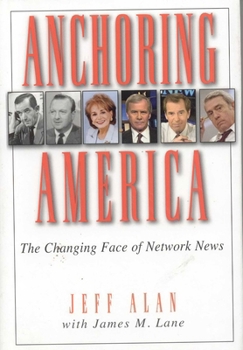Anchoring America
No Synopsis Available.
Format:Hardcover
Language:English
ISBN:156625194X
ISBN13:9781566251945
Release Date:November 2003
Publisher:Taylor Trade Publishing
Length:426 Pages
Weight:1.70 lbs.
Dimensions:1.5" x 6.4" x 9.3"
Customer Reviews
1 rating
THE HILL REVIEWS ANCHORING AMERICA
Published by Thriftbooks.com User , 21 years ago
Anchors away? A look at how TV news is changingBy John KornackiYou know it's going to happen, and it's infuriating. The president of the United States has just finished the State of the Union speech, and Tom Brokaw (or Peter Jennings or Dan Rather) will tell you what he just said and what was important. He will say something about the delivery of the speech, too. Though he is trying to be objective and analytical, the selection of key points from a speech is basically a matter of individual judgment; any impression about the delivery is strictly subjective. Some viewers are fed up with what they see as a condescending and patronizing attitude expressed by today's news anchors. Others are miffed by perceived bias. Either way, if you look at the ratings, more and more viewers are looking at alternatives to the network news offered by the cable channels or by new media like the Internet. Still others tune out to watch Paris Hilton, QVC or anything but the news. To blame Brokaw et al. for the falloff is to fault their mentors, the men who pioneered the role of anchorman and set formulas that had worked for a generation or two. When John Chancellor or Walter Cronkite summed up key news items and events, we accepted it: "That's the way it is," said Uncle Walter, the most trusted man in America. So what happened to television news and the people delivering it over the past 20 years? Did something happen to us? Television journalist Jeff Alan and writer James M. Lane provide some answers to these questions in Anchoring America. To understand the modern television anchorman or -woman, one must go back to its creation by a man who didn't think much of TV as a news medium and never really sat in the TV anchor chair: Edward R. Murrow of CBS News. Murrow was a renaissance radioman, as Alan says, "equal parts journalist, celebrity, arranger, composer and keeper of the public trust." Murrow's deep voice was a model of finely tuned inflection and measured delivery. It was uniquely American - tough, skeptical and, somehow, soothing. He sounded (and looked) like Humphrey Bogart in Casablanca. Murrow's great gift, however, was in identifying and organizing talent. He knew newsmen and could get the most out of them. He expanded news programming and enhanced the prestige of CBS. From Murrow's team came Eric Sevareid and Charles Collingwood. The other two networks followed similar formats based on the Murrow mold of the trusted journalist-commentator as anchorman. The two biggest factors in changing television news came from outside of news. According to Alan and Lane, these factors were entertainment and technology. The first big change began with the innovative Roone Arledge and the success of ABC's Monday Night Football in the early '70s. Arledge proved that new formats and new thinking worked in ways that attracted key audiences. The three-person booth, event programming and edgy commentary evolved into similar audience-attracting experiments with the then moribun





